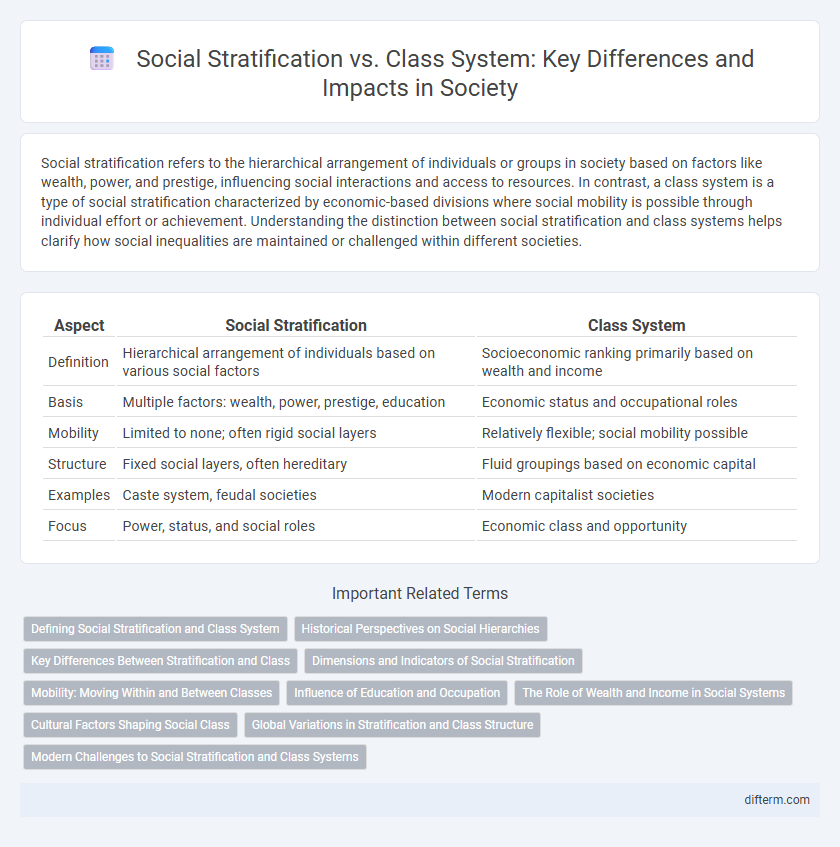Social stratification refers to the hierarchical arrangement of individuals or groups in society based on factors like wealth, power, and prestige, influencing social interactions and access to resources. In contrast, a class system is a type of social stratification characterized by economic-based divisions where social mobility is possible through individual effort or achievement. Understanding the distinction between social stratification and class systems helps clarify how social inequalities are maintained or challenged within different societies.
Table of Comparison
| Aspect | Social Stratification | Class System |
|---|---|---|
| Definition | Hierarchical arrangement of individuals based on various social factors | Socioeconomic ranking primarily based on wealth and income |
| Basis | Multiple factors: wealth, power, prestige, education | Economic status and occupational roles |
| Mobility | Limited to none; often rigid social layers | Relatively flexible; social mobility possible |
| Structure | Fixed social layers, often hereditary | Fluid groupings based on economic capital |
| Examples | Caste system, feudal societies | Modern capitalist societies |
| Focus | Power, status, and social roles | Economic class and opportunity |
Defining Social Stratification and Class System
Social stratification refers to the hierarchical arrangement of individuals or groups in a society based on factors like wealth, power, and social status, creating layers of inequality. The class system categorizes people primarily by economic position, emphasizing mobility between classes through achieved status rather than fixed social roles. Understanding these distinctions highlights how social stratification structures opportunities and access within societies, influencing individual life chances.
Historical Perspectives on Social Hierarchies
Historical perspectives on social hierarchies reveal that social stratification often stems from rigid, hereditary systems like caste or feudal classes, where status and occupation are predetermined by birth. In contrast, class systems, emerging prominently during the Industrial Revolution, emphasize economic factors and allow for greater social mobility through wealth and education. These evolving frameworks highlight shifting power dynamics and the complex interplay between structural constraints and individual agency in shaping social inequality.
Key Differences Between Stratification and Class
Social stratification refers to the hierarchical arrangement of individuals in society based on factors like wealth, power, and prestige, while the class system emphasizes economic status and mobility. Stratification is often rigid and inherited, limiting movement between layers, whereas class systems allow for social mobility through achievement or economic changes. Key differences include the basis of ranking, the degree of flexibility, and the criteria used for categorization.
Dimensions and Indicators of Social Stratification
Social stratification is characterized by hierarchical layers defined by dimensions such as wealth, power, and prestige, whereas class systems primarily focus on economic factors and social mobility. Key indicators of social stratification include income levels, occupational status, educational attainment, and access to resources, reflecting variations in life opportunities and social influence. These dimensions collectively shape societal inequalities, influencing individuals' social positions and interactions within the stratified structure.
Mobility: Moving Within and Between Classes
Social stratification defines the hierarchical arrangement of individuals based on wealth, power, and status, while the class system allows for greater social mobility, enabling people to move within and between classes. Mobility within classes often involves changes in occupation or income without altering one's overall social class, whereas interclass mobility signifies a shift from one class to another, influenced by factors such as education, economic opportunities, and social networks. Understanding these dynamics highlights how structured inequalities persist despite opportunities for individual advancement.
Influence of Education and Occupation
Education significantly shapes social stratification by determining individuals' access to knowledge and skills, which in turn impacts their occupational opportunities and earning potential. Occupation reflects and reinforces class distinctions, as higher-status jobs typically require advanced education and offer greater economic rewards, perpetuating social inequalities. Together, education and occupation function as critical mechanisms through which social classes are formed and maintained within a class system.
The Role of Wealth and Income in Social Systems
Wealth and income play a pivotal role in both social stratification and class systems by determining access to resources, opportunities, and social status. In stratified societies, disparities in financial capital reinforce hierarchical divisions, while class systems categorize individuals based largely on economic standing and occupational prestige. This economic differentiation influences life chances, shaping individuals' education, healthcare, and social mobility outcomes.
Cultural Factors Shaping Social Class
Cultural factors such as values, beliefs, language, and education significantly shape social class by influencing individuals' behaviors and opportunities within social stratification. Cultural capital, including tastes, knowledge, and skills, reinforces class distinctions and affects social mobility by aligning individuals with specific social groups. These cultural elements perpetuate class differences by shaping access to resources and social networks critical for economic and social advancement.
Global Variations in Stratification and Class Structure
Global variations in social stratification reveal diverse class systems shaped by historical, economic, and cultural factors. Highly industrialized nations often exhibit more fluid class mobility compared to rigid caste-like systems in some developing regions. Structural inequalities persist worldwide, affecting access to resources, education, and political power across different social strata.
Modern Challenges to Social Stratification and Class Systems
Modern challenges to social stratification and class systems include increasing economic inequality driven by globalization, technological advancements, and labor market shifts. Social mobility is hindered by structural barriers such as limited access to quality education, healthcare disparities, and systemic discrimination. These factors contribute to the persistence of entrenched class divisions despite efforts toward social equity.
social stratification vs class system Infographic

 difterm.com
difterm.com